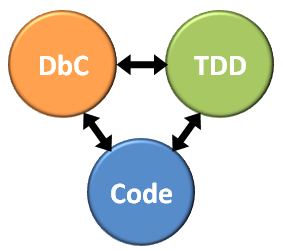(Note: this article has been updated on 2009/05/16 by replacing the example and adding some more information)
Modelling constraints on class properties and valid state of classes explicitly is an interesting topic and sometimes I catch myself being frustrated by the lack of handling these aspects through current programming languages. With „constraint“ I mean a condition on one class property or on a set, which equals a subset of the properties for the class. The same is true for the „state of a class“. Periodically I run into situations, where I have for example two properties, whose values depend on each other. And what I want is to express explicitly, that when property 1 is in state X, then property 2 must be in state Y and vice versa and that this constraint on those properties (their depending state) mustn’t be broken!
Let’s consider a (very) little example in form of the following class MinMax:
public class MinMax
{
public int MinValue { get; set; }
public int MaxValue { get; set; }
}
Not too impressive, isn’t it? 😉 But as you can imagine, there is one obvious constraint: MinValue <= MaxValue. Two other constraints are related to each property for itself – they mustn’t be less than 0: MinValue >= 0 and MaxValue >= 0 must be true. If those 3 conditions are true, then the class can be seen to be in a valid state. And in this case, we want to ensure this valid state all the time. The question follows quickly: How to model these constraints? Normally, you as programmer wouldn’t be very concerned about that. For example, in the setters of MinValue and MaxValue, you would check the constraints and throw an exception, if they don’t hold:
public class MinMax
{
private int _MinValue;
public int MinValue {
get { return _MinValue; }
set
{
if (value %gt; MaxValue)
throw new ArgumentException("value can't be greater than MaxValue");
if (value < 0)
throw new ArgumentException("value can't be less than 0");
_MinValue = value;
}
}
private int _MaxValue;
public int MaxValue
{
get { return _MaxValue; }
set
{
if (value < MinValue)
throw new ArgumentException("value can't be less than MaxValue");
if (value < 0)
throw new ArgumentException("value can't be less than 0");
_MaxValue = value;
}
}
}
There’s an even better way, when you use a Guard class for that. Better, because you’ve outsourced the exception throw into the guard and you can do additional things there like logging something:
public class MinMax
{
private int _MinValue;
public int MinValue
{
get { return _MinValue; }
set
{
Guard.Against<ArgumentException>(
value > MaxValue, "value can't be greater than MaxValue");
Guard.Against<ArgumentException>(
value < 0, "value can't be less than 0");
_MinValue = value;
}
}
private int _MaxValue;
public int MaxValue
{
get { return _MaxValue; }
set
{
Guard.Against<ArgumentException>(
value < MinValue, "value can't be less than MaxValue");
Guard.Against<ArgumentException>(
value < 0, "value can't be less than 0");
_MaxValue = value;
}
}
}
public static class Guard
{
public static void Against<TException>(bool assertion, string message)
where TException : Exception
{
if (assertion)
throw (TException)Activator.CreateInstance(typeof(TException), message);
}
}
So it seems to be pretty easy to handle our constraints, right? Please don’t just take this stupid example into account. Imagine more complex cases, where you have numerous constraints on your class properties (one property or more than one depending properties), which aren’t far so obvious as in this example. Can you imagine the problems which arise, when you model them implicitly?
What if we would have a mechanism to model such (depending) property constraints explicitly, thus expressing valid class states? This would have some interesting advantages. First it helps you as programmer in creating and extending your class by ensuring that the constraints are maintained. Second it works as checked documentation for your code. If other programmers are extending your class, they would be aware of the constraints. By making things explicit and code-checked, it’s ensured that your classes are in valid state at every time by watching the defined constraints. Take MinMax as an example yet again. If you or another programmer is extending the class, you are not forbidden to write _MinValue and _MaxValue directly, thus going around the „state maintainers“ in form of the setters in MinValue and MaxValue and the calls to Guard. This example is small enough to not getting confused, but in more tricky cases the class could be left easily in an inconsistent state and yield more problems. An explicit model could lead a way out of that! Third when you distribute your components to third-party users, you would yet again reveal your intent by making the constraints of the class explicit. Users would be aware of them and could easier reproduce the behavior of your components. Hence there’s a much better chance that they use your class in a proper way from the beginning.
Do we have a mechanism to model such things? First if we think about class state, perhaps the GoF State pattern comes into mind, but that doesn’t fit our needs. It doesn’t have the power to make constraints explicit and model valid class state. But we can use Code Contracts for that! Object invariants (= invariants on classes) are exactly what we need. Object invariants give us the power to model constraints on classes explicitly, check them at compile and/or runtime (using the static or dynamic checker) and moreover allow us to define them on interfaces and abstract classes! Implementing/deriving classes must maintain the defined invariants and are allowed to make them stronger (but not weaker). So how would our MinMax-class look with that? Let’s see:
public class MinMax
{
public int MinValue { get; set; }
public int MaxValue { get; set; }
[ContractInvariantMethod]
protected void ClassConstraints()
{
Contract.Invariant(MinValue >= 0);
Contract.Invariant(MaxValue >= 0);
Contract.Invariant(MinValue <= MaxValue);
}
}
That’s really small and seems to be pretty, doesn’t it? With the ContractInvariantMethod we can declare a method that contains the invariants/constraints of the class, which must be maintained by every class method (including get/set on properties). This method and its checks are run on exit of every other class method. With Contract.Invariant() you’re able to define an invariant. It doesn’t matter if there are simple cases as here or more complex cases on depending properties (for example implications) – every boolean expression can be modelled with that.
However somebody could find some issues with this example, so let’s explain. The above code is pretty, because the constraints are outsourced to one single method (thus avoiding redundancies) and you haven’t to take care of calling this method everytime (because Code Contracts will call it for you on exit of every other method).
As first issue, callers (clients) of the MinValue.set and MaxValue.set methods don’t see directly which values are allowed, because it’s not part of the method contract (the preconditions on the setters). In this example it’s ok, because he can look at the invariants (the contract of the whole class) and see, which values are allowed. So this issue is weak here, but in other method cases you really have to duplicate invariants with preconditions, what is some kind of ugly.
Second, the static checker will not be happy with that code, because it’s aware of that you can provide some invalid value in the setters. That’s an issue of Code Contracts itself and I hope the team will come up with some further development to handle this case automatically. So this issue is weak as well.
The third issue seems to be stronger. If an invariant is broken and hence a ContractException is thrown, the wrong value will remain in the current MinMax instance, if you handle the exception outside with try/catch (MinMax is left in an invalid state). If you don’t use the object anymore, that’s no problem, but else you have no chance to go to the state before the exception was thrown, except you’re handling that on your own in the caller/client. Is this a really good issue? Again, it’s not. This issue goes away, if we look at the purpose and behavior of DbC for this case. In DbC the client is responsible for ensuring preconditions when calling a method and if it comes to properties, he has to respect the invariants, too. If the client breaks a method’s contract, then the method itself is not obligated to ensure defined behavior – it’s simply undefined. And since contracts should be compiled out from the release version (while debugging and testing has been run before), that’s no problem at all. The break of a contract means the presence of a bug. The client should not handle such a case (handle the bug) by catching the exception and then further using the object. The object should be thrown away and the client must take care to call the method in a proper way.
As you can see, there are no definite issues with this example. Fortunately for true, because including preconditions in every setter would have meant to duplicate assertions as preconditions and invariants and this would destroy the advantage of having minimal check redundancies compared with the concept of defensive programming.
This article has shown some interesting aspect of Code Contracts. Modelling constraints (on (depending) properties) and valid class states is not handled very well by programming languages and easily yields to various coding problems, since your intention isn’t made explicit and valid class state isn’t checked automatically. Code Contracts can help us in this case very well by the use of object invariants. One more time making things explicit helps you as programmer and other programmers that use or extend your components.



 To say first, Test-Driven Development (TDD) and Design by Contract (DbC) have very similar aims. Both concepts want to improve software quality by providing a set of conceptual building blocks that allow you to prevent bugs before making them. Both have impact on the design or development process of software elements. But both have their own characteristics and are different in achieving the purpose of better software. It’s necessary to understand commonalities and differences in order to take advantage of both principles in conjunction.
To say first, Test-Driven Development (TDD) and Design by Contract (DbC) have very similar aims. Both concepts want to improve software quality by providing a set of conceptual building blocks that allow you to prevent bugs before making them. Both have impact on the design or development process of software elements. But both have their own characteristics and are different in achieving the purpose of better software. It’s necessary to understand commonalities and differences in order to take advantage of both principles in conjunction.
 In essence, DbC and TDD are about specification of code elements, thus expressing the shape and behavior of components. Thereby they are extending the specification possibilities that are given by a programming language like C#. Of course such basic code-based specification is very important, since it allows you to express the overall behavior and constraints of your program. You write interfaces, classes with methods and properties, provide visibility and access constraints. Furthermore the programming language gives you possibilities like automatic boxing/unboxing, datatype safety, co-/contravariance and more, depending on the language that you use. Moreover the language compiler acts as safety net for you and ensures correct syntax.
In essence, DbC and TDD are about specification of code elements, thus expressing the shape and behavior of components. Thereby they are extending the specification possibilities that are given by a programming language like C#. Of course such basic code-based specification is very important, since it allows you to express the overall behavior and constraints of your program. You write interfaces, classes with methods and properties, provide visibility and access constraints. Furthermore the programming language gives you possibilities like automatic boxing/unboxing, datatype safety, co-/contravariance and more, depending on the language that you use. Moreover the language compiler acts as safety net for you and ensures correct syntax.






